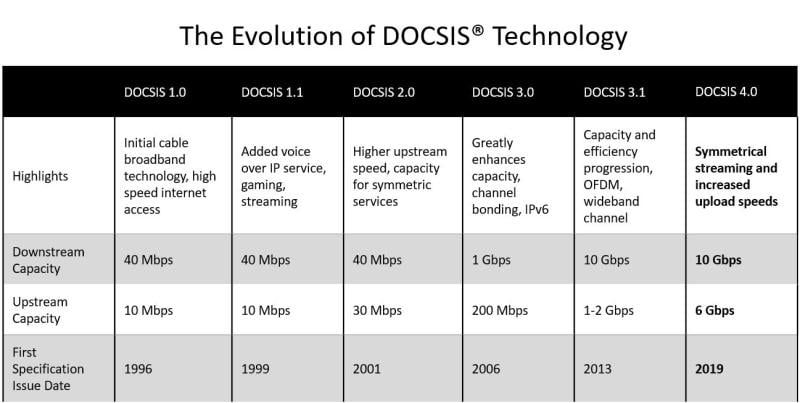You may have heard companies like Comcast, Charter Communications and Cox Communications say something called “DOCSIS 4.0” will let them provide users with blazing fast speeds for applications like AR/VR, gaming, online learning, telemedicine and more. But what exactly is DOCSIS 4.0 and how is it going to make the internet faster?
Let’s start with basics. DOCSIS is an acronym that stands for Data Over Cable Service Interface Specifications. Put simply, DOCSIS is an industry standard that is an instruction manual for operators looking to enable high-bandwidth data communications. DOCSIS is mainly used by cable operators who have hybrid-fiber coaxial (HFC) infrastructure. But Curtis Knittle, VP of Wired Technologies at CableLabs, noted it can also be used for fiber-to-the-home, telling Fierce “many people don’t know cable has had an FTTH solution for years.” That solution, called RF over Glass, has largely fallen out of fashion in favor of passive optical network (PON) fiber solutions.
There have been many iterations of DOCSIS over the years, all of which have come from a telecom industry group called CableLabs. The original DOCSIS 1.0 was followed by 1.1, 2.0, 3.0 and 3.1. The DOCSIS 3.1 standard, which was released in late 2013, enabled download speeds of 10 Gbps and upload speeds of up to 2 Gbps.

DOCSIS 4.0 takes things a step further, enabling the same 10 Gbps download speeds and upload speeds of up to 6 Gbps. This will allow cable operators to offer symmetrical multi-gigabit internet plans to match offerings from fiber internet providers.
According to Knittle, DOCSIS 4.0 “leverages many of the same technologies as used in DOCSIS 3.1, particularly OFDM and OFDMA.” The main difference is that DOCSIS 4.0 expands the total amount of spectrum available for upstream and downstream transmissions. As Knittle put it, “More spectrum, more capacity, more happy customers.”
The DOCSIS 4.0 standard was released in March 2020, but it generally takes a few years for a new iteration of DOCSIS to be rolled out in the networks consumers use. That’s because operators have to wait for network equipment suppliers to develop the necessary components and they also have to test the technology to ensure it works seamlessly in a real-world environment.
Unlike earlier DOCSIS standards, the 4.0 version offers different ways for operators to achieve the same speed goal. The first is known as full duplex DOCSIS (FDX). Favored by Comcast, FDX involves the simultaneous transmission of data upstream and downstream using the same spectrum. The second is called extended spectrum DOCSIS (ESD – also called frequency division duplex or FDD). This option allocates separate chunks of spectrum for the upstream and downstream lanes of traffic. Charter, Cox and several others are pursuing ESD.
DOCSIS 4.0 isn’t available to consumers yet, and it is unclear when it will be deployed.
Asked whether DOCSIS 4.0 will be the final DOCSIS standard given the telecom industry push to deploy fiber, Knittle said he thinks that’s unlikely.
“There are architecture evolutions that are still possible, and potentially more coaxial spectrum to be exploited, both of which leverage coaxial cable already in the ground. This ultimately provides cable operators with excellent opportunities to incrementally invest in the network and reap even more capacity from their installed networks,” he concluded.
